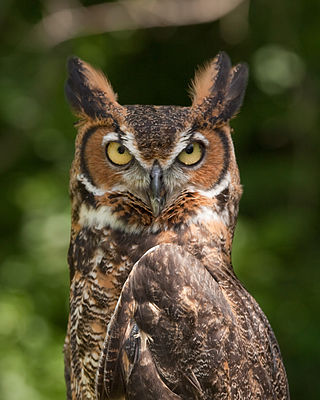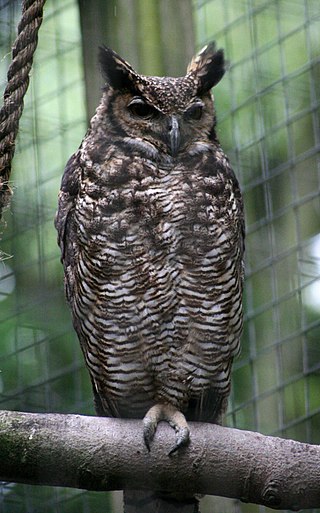
Owls are birds from the order Strigiformes, which includes over 200 species of mostly solitary and nocturnal birds of prey typified by an upright stance, a large, broad head, binocular vision, binaural hearing, sharp talons, and feathers adapted for silent flight. Exceptions include the diurnal northern hawk-owl and the gregarious burrowing owl.

The true owls or typical owls are one of the two generally accepted families of owls, the other being the barn owls and bay owls (Tytonidae). This large family comprises 230 living or recently extinct species in 24 genera. The Strigidae owls have a cosmopolitan distribution and are found on every continent except Antarctica.

The bird family Tytonidae, which includes the barn owlsTyto and the bay owlsPhodilus, is one of the two families of owls, the other being the true owls or typical owls, Strigidae. They are medium to large owls with large heads and characteristic heart-shaped faces. They have long, strong legs with powerful talons. They also differ from the Strigidae in structural details relating in particular to the sternum and feet.

The American horned owls and the Old World eagle-owls make up the genus Bubo, at least as traditionally described. The genus name Bubo is Latin for owl. Its name in Russian филин is one of the few native Russian words containing the letter Ф.

The Eurasian eagle-owl is a species of eagle-owl, a type of bird that resides in much of Eurasia. It is often just called the eagle-owl in Europe and Asia.

The snowy owl, also known as the polar owl, the white owl and the Arctic owl, is a large, white owl of the true owl family. Snowy owls are native to the Arctic regions of both North America and the Palearctic, breeding mostly on the tundra. It has a number of unique adaptations to its habitat and lifestyle, which are quite distinct from other extant owls. One of the largest species of owl, it is the only owl with mainly white plumage. Males tend to be a purer white overall while females tend to have more extensive flecks of dark brown. Juvenile male snowy owls have dark markings that may appear similar to females until maturity, at which point they typically turn whiter. The composition of brown markings about the wing, although not foolproof, is the most reliable technique to age and sex individual snowy owls.

The great horned owl, also known as the tiger owl or the hoot owl, is a large owl native to the Americas. It is an extremely adaptable bird with a vast range and is the most widely distributed true owl in the Americas. Its primary diet is rabbits and hares, rats and mice, and voles, although it freely hunts any animal it can overtake, including rodents and other small mammals, larger mid-sized mammals, birds, reptiles, amphibians, and invertebrates.

The brown fish owl is a fish owl species in the family known as typical owls, Strigidae. It is native from Turkey to South and Southeast Asia. Due its wide distribution it is listed as Least Concern on the IUCN Red List. It inhabits forests and wooded wetlands. Of the four living species of fish owl, it is the most widely distributed, most common and best-studied. It occupies a range of over 7,000 km (4,300 mi).

Blakiston's fish owl, the largest living species of owl, is a fish owl, a sub-group of eagle-owls that specialize in hunting in riparian areas. It is native to China, Japan, and the Russian Far East. This species is a part of the family known as typical owls (Strigidae), which contains most species of owl. Blakiston's fish owl and three other piscivorous owls are placed with some eagle-owls in the genus Ketupa. Its habitat is riparian forest with large, old trees for nest sites near lakes, rivers, springs, and shoals that do not freeze in winter. Henry Seebohm named this bird after the English naturalist Thomas Blakiston, who collected the original specimen in Hakodate on Hokkaidō, Japan in 1883.

The spot-bellied eagle-owl, also known as the forest eagle-owl is a large bird of prey with a formidable appearance. It is a forest-inhabiting species found in the Indian Subcontinent and Southeast Asia. This species is considered part of a superspecies with the barred eagle-owl, which looks quite similar but is allopatric in distribution.

Chatkal State Nature Reserve is a reserve in the Tashkent Province of Uzbekistan comprising about 570 square kilometres of mountain steppes, mountain forests, alpine meadows, river valleys and floodplain forests. The state nature preserve was established here in 1947, and it was designated a UNESCO biosphere reserve in 1978. The most important river in this area is the Tereklisay, flowing from south to north across the nature reserve.

The Philippine eagle-owl is a vulnerable species of owl belonging to the family Strigidae. It is endemic to the Philippines, where it is found in lowland forests on the islands of Catanduanes, Samar, Bohol, Mindanao, Luzon, Leyte and possibly Sibuyan. While it is the largest owl in the Philippines, it is relatively small compared to other members of its genus. It is a vulnerable species with its population on the decline. Its main threats are habitat destruction, hunting and poaching for the pet trade.

Verreaux's eagle-owl, also commonly known as the milky eagle owl or giant eagle owl, is a member of the family Strigidae. This species is widespread in sub-Saharan Africa. A member of the genus Ketupa, it is the largest African owl, measuring up to 66 cm (26 in) in total length. This eagle-owl is a resident primarily of dry, wooded savanna. Verreaux's eagle-owl is mainly grey in color and is distinguishable from other large owls by its bright pink eyelids, a feature shared with no other owl species in the world.

The Bengal eagle-owl, also widely known as the Indian eagle-owl or rock eagle-owl, is a large horned owl species native to hilly and rocky scrub forests in the Indian Subcontinent. It is splashed with brown and grey, and has a white throat patch with black small stripes. It was earlier treated as a subspecies of the Eurasian eagle-owl. It is usually seen in pairs. It has a deep resonant booming call that may be heard at dawn and dusk.

The Sophiornithidae are an extinct family of chicken-sized predatory birds that lived from the Paleocene to the Eocene periods of the Cenozoic, and were found primarily in Europe, and are thought to be primitive owls.

Fraser's eagle-owl is a species of African owl in the family Strigidae. It is named after the British zoologist Louis Fraser.

Ketupa is a genus of owls in the family Strigidae. The genus formerly contained just three species, the fish owls but based on the results from a genetic study published in 2020, the generic boundaries were altered. The genus now contains twelve species, nine of which were formerly placed in the genus Bubo.

The buffy fish owl, also known as the Malay fish owl, is a fish owl in the family Strigidae. It is native to Southeast Asia and lives foremost in tropical forests and wetlands. Due to its wide distribution and assumed stable population, it is listed as Least Concern on the IUCN Red List since 2004.

The South American great horned owl, also known as the Colombian great horned owl, Venezuelan great horned owl, or desert great horned owl, is a subspecies of the great horned owl, Bubo virginianus. It lives in tropical South America. It generally occurs in more open areas than the North American great horned owls, and avoids dense humid forest, e.g. the Amazon Rainforest. Unlike other subspecies of the great horned owl, the eyes of the South American horned owl are amber rather than yellow. Although the largest owl in its range, it is a relatively small horned owl.
Ogygoptynx is an extinct genus of owl from the Paleocene. Dated to the Late Paleocene, this is the earliest known owl fossil, with a single species assigned to the taxon: Ogygoptynx wetmorei.

















